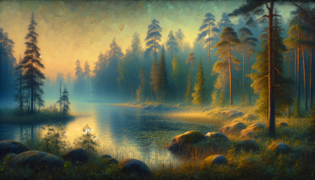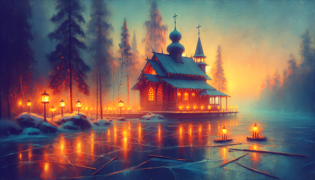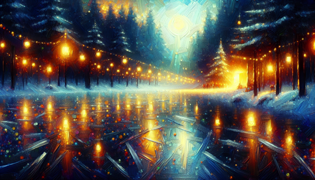The Lake Spirit of Saimaa: Finland’s Enchanting Water Sirens
Reading Time: 12 min

About Story: The Lake Spirit of Saimaa: Finland’s Enchanting Water Sirens is a Legend Stories from finland set in the Ancient Stories. This Descriptive Stories tale explores themes of Nature Stories and is suitable for All Ages Stories. It offers Cultural Stories insights. A haunting Finnish legend of sirens whose song frees seals yet tempts travelers into icy waters.
Introduction
Before the first frost painted the shores of Saimaa with silver lace, an ancient lullaby drifted across the water, carried on a breeze redolent of pine resin and damp stone. In villages nestled among pines and birch, elders spoke in hushed tones of a water spirit whose song, sweeter than wild honey, eased trapped seal pups from their icy prisons. On moonlit evenings, the mist clung to the surface like a gossamer veil, inviting those who heard its siren call to edge closer to the mirrored depths. Children were warned never to answer the melody that sounded like moonlight draped over snow, for curiosity, they said, could vanish a soul as quickly as a fish darting beneath the ice. Yet the legend persisted—how the lake, alive as a sleeping giant, exhaled a song that could break a winter’s hold and restore life to the youngest of seals.
The air would cool to the taste of slate and wet grass when the sirens began to sing. Their voices wove through the forest as though carried on a dancer’s scarf of mist, coaxing both fear and fascination in equal measure. In fact, many fishermen claimed they stood "olla kuin kala vedessä," like a fish in water, at home near these shores—yet none were immune to the melancholic pull of the harmonies. Even in the warmth of a woodsmoke-scented cottage, the faintest hum might send hearts racing, prompting hunters to glance toward the frozen lake, where they imagined the pale forms of spirits gliding beneath the stars.
This tale, passed down by lips crusted with the tang of rye bread, reminds us that nature’s gifts arrive on a blade of ice: they can heal, but they can also ensnare. And so, under the shimmer of northern lights and cracking ice, the Lake Spirit of Saimaa watches and waits.
Origins of the Sirens of Saimaa
Long before human footsteps disturbed the pebbled shores of Saimaa, the lake lay as silent and dark as a hidden heart, shielded by forests that whispered secrets to the wind. The water stretched beyond the horizon in every direction, reflecting a sky that shifted from rose to violet with breathtaking speed. That vast expanse was more than mere liquid; it was memory and magic entwined. Villagers who lived along the shores spoke of a time when ice formed so thick that it held the world in a crystalline embrace, trapping seal pups beneath its surface. Then, at the faintest crack—like the soft snap of a twig underfoot—a melody would rise. It sounded like silver goblets chime in the gloaming, woven with notes sweeter than the milkiest honey, and it carried the tang of river clay, the rustle of reeds, and the distant echo of a spruce branch creaking in the wind. Some said it was the bond between lake and sky, manifest in voice. Others believed a hidden folk—half-spirit, half-fish—dwelt within, waiting each winter to free the youngest seals from their icy tombs.
According to the oldest tales, the first song was born when a guardian spirit fell in love with a lone seal pup stranded beneath a frozen sheet. In those days, lore tells, people offered jewelry and prayers: silver brooches laid gently atop the ice, carved wooden charms hung from nets, and bowls of fresh water poured into the lake’s mouth. Each gift sought to honor the spirit’s kindness and beg her to continue the life-saving ritual. Over time, a pact emerged: if the village left offerings at the first crack’s edge, blossom-thin and white against the blue, the siren’s voice would rise to cleave the ice open like a blade through silk. They called her Ääniluoti, the Echo-Bullet, swift and precise, her song slicing winter’s hold without harming the seals below. It was said that when she sang, the entire lake trembled gently, as though awakening from a long dream. The air smelled faintly of salted brine even though Saimaa is fresh water, and some who listened claimed to feel the smooth pressure of a hidden current brushing against their bare toes.
Despite the kindness woven into the pact, fear grew in equal measure. Rumors spread of wanderers drawn too close—men who followed the melody beyond the cracked edge and slipped beneath the ice, women who lost their way in a swirl of reflections that danced like will-o’-the-wisps under the surface. Parents would hush children at dusk, warning them that to hear that otherworldly tune was both blessing and curse. Yet even the most cautious soul found the music irresistible, for it was carried on the wind like a promise of something greater, a longing that rooted itself deep in the human heart. Smelling of wet pine needles and granite dust, the siren’s song felt at once comforting and alien, as though reminding listeners they were both part of this world and doomed to remain forever outside of its most secret mysteries.

The Haunting Melody That Breaks the Ice
When winter’s grip tightened, layers of ice formed a tapestry of white and azure across Saimaa, and the villagers waited in hushed anticipation. They wrapped themselves in thick wool cloaks that still smelled of sheep’s fleece warmed by embers, and they listened for the first crack resonating beneath their boots. That sound, sharp as a clasp clinking on a fur collar, signaled the moment to gather at the ice edge. With lanterns held high, their flames dancing like captive fireflies, they stood in a semi-circle, breath visible in ghostly puffs. Then came the melody: a single note at first, pure as a dewdrop balanced on a blade of grass, followed by a chorus that rolled across the ice with the sureness of a tide. It echoed like swansong over frozen ground, carrying the muscular scent of river weeds and the faint rustle of distant birch branches. Each note seemed to carve a path through the ice, unzipping the frost layer by layer.
As the song swelled, tiny fissures spidered outward, catching the lantern glow and reflecting a thousand sparkles. The villagers watched in silent awe, their ears ringing with harmonics that felt both joyful and sorrowful, as if the lake itself were grieving and celebrating simultaneously. Under the glow of their torchlight, the ice surrendered to the song, splitting along lines so precise they looked manmade. Seals poked their heads through the narrow openings, whiskers trembling with gratitude. Their dark eyes shone like polished obsidian as they dove beneath and reemerged, their sleek bodies cutting through the water with effortless grace. The villagers murmured blessings, tossing wooden pucks carved with runes into the newly formed pools as tokens of respect.
Yet the same melody that liberated seals also carried peril. Mariners who lingered too long found themselves entranced, each note winding its way through muscle and bone. There are accounts of hunters drifting into yawning chasms created by the breaking ice, their footprints swallowed by snow within moments. Some perished in silence, others returned blank-eyed, reciting fragments of the song that slipped into dreams like a slippery fish writhing free. In one tale, a lone traveler described hearing the voice close behind him on a moonless night, whispering secrets about hidden depths and ancient covenants. He claimed the music smelled of moss and honeycomb and that each syllable felt like soft silk brushing against his cheek. He never spoke of it again, and when dawn broke, his footprints led only to the water’s edge before fading beneath the waves.

Tales of Lost Wanderers
Stories of those who vanished spread like wildfire through the timber-framed cottages of Saimaa’s settlements. Every hearth brimmed with accounts of men and women led astray by an unseen chorus, their last words trailing off in the cold air like the final echo of a church bell. One such tale involves Ilkka, a woodsman from the village of Savonlinna. He returned from the forest with boots crusted in fresh snow and spoke of a melody that lured him across the ice. He said it was as if the lake beckoned him by name, promising a glimpse of wonders hidden beneath the surface. Ilkka followed the song until he stood on unsupported ice, feeling the water’s chill lap at his ankles despite the thick crust overhead. He froze in place, mesmerized, until a cracking sound snapped him back to reality just as the ice split beneath his weight. He dove into the frigid water, dragging himself to safety with numb arms. His clothes smelled of fish slime and cold mist when he staggered ashore, and though he lived, the vibration of that near-death melody haunted his dreams for the rest of his days.
Then there is the legend of the silver harp, an artifact said to hold the voice of Ääniluoti herself. According to local lore, a traveling bard discovered the harp beneath a natural grotto along the eastern bank, its strings carved from birch roots and strung with purified water. When he played even a single chord, the ice around the instrument trembled and fractures sprouted like frost flowers. Word reached the spirit, who descended in a swirl of emerald-green water and demanded the harp’s return. The bard, mesmerized, tried to bargain, offering gold and promises of tales sung far beyond the northern reaches. But the siren’s voice rose in protest—an anguished cry that sounded like glass shattering under a hammer—sending waves that shattered nearby ice floes and swept the harp into the deep. The bard vanished soon after, leaving only his footprints frozen in place, an eternal reminder of fate’s fragile edge.
In more recent times, travelers have reported hearing a faint echo of that ancient melody when driving along quiet roads beside the lake. They describe windows shuttering on their own, headlights flickering, and a distant pitch that threads through a radio static channel. Some stop to listen, drawn by an inexplicable melancholy that tugs at their soul, only to find the roadside water turning to mist before their eyes. These accounts blend superstition and modernity, yet they share a single refrain: the Lake Spirit still sings each winter, balancing life and loss on a razor-thin edge. Even those who refuse to believe in sirens admit that Saimaa’s winters hold a haunting beauty, as if the very world pauses to honor something unseen and sacred.

Legacy in Modern Finland
Today, the legend of the Lake Spirit of Saimaa endures in festivals and local lore. Each February, communities gather on the ice to host a midwinter celebration: lantern processions wind across frozen surfaces as folk musicians play kantele and accordions, and the scent of grilled fish mingles with the woodsmoke drifting from cozy cabins. Ice sculptors carve intricate seals and sirens, their forms shimmering under strings of colored lights. Elders retell the tale, warning young couples to respect both the gift and the danger of the siren’s song. Visitors hoping for a thrill sometimes venture out with smartphone recorders, only to complain of strange feedback and mysterious echoes that no app can explain. They speak of hearing a gentle hum beneath every crack of ice, a promise that nature still holds secrets beyond human reach.
Researchers have taken interest too: marine biologists study Saimaa’s rare ringed seals, whose survival once depended on the siren’s intervention. Geneticists note that the seals’ population spike centuries ago coincides with tales of an ice-cleaving chorus strong enough to carve breathing holes through a meter of frost. Historians examine church records that mention unusual gatherings on ice, interpreting them as ritualistic honors for a lake deity. Folklorists debate whether Ääniluoti was originally a pagan goddess absorbed into Christian customs or a symbol of humanity’s ancient bond with water. Whatever the origin, the spirit remains a potent reminder of the lake’s unpredictability and generosity.
On quiet nights, when the wind drops and the air smells faintly of juniper and charcoal, some swear they can still hear the echoing refrain of a song that unzipped winter’s cloak. It drifts across the water like a distant Bell of Kyrö, reminding listeners that nature’s mercy and menace often dwell side by side. In Saimaa, people live in cautious reverence, planting trees at the water’s edge and releasing hatchling fish as offerings. They know that true harmony demands respect and remembrance—lest the lake remember how easily humans can forget the ancient pacts written beneath its depths.

Conclusion
Though centuries have passed since the first song cleaved Saimaa’s ice, the legend of the freshwater siren remains as vital as the current running beneath each winter’s frost. In every crack of ice and every breath of mist, we sense the lingering cadence of a melody older than memory itself, reminding us that nature’s heartbeat pulses beyond human control. Village children grow up hearing the tale, sparking both wonder and caution: they learn that magic lives on the edge of the known world, in places where water and stone meet under a fragile crust of ice.
This story teaches us that life often balances on a thin sliver of possibility. The sirens’ song can grant freedom—thawing the ice to save the most vulnerable—or usher in tragedy, claiming those who fail to heed the boundary between reverence and recklessness. As Finland’s winters lengthen and climate patterns shift, the fate of Saimaa’s ringed seals remains uncertain, just as it was when elders first forged a bargain with the water’s spirit. Each midwinter gathering and each scientific study offers a chance to honor that ancient promise, blending tradition with modern care.
In the hush of a frozen dawn, when mist hovers over pristine sheets of ice and the faint hum of something ancient threads through the air, pause and listen. For in that moment, you stand at the threshold of a timeless story—where blessing and peril flow from the same source, and where hope, like the first crack in winter’s hold, may emerge from even the coldest depths.

















